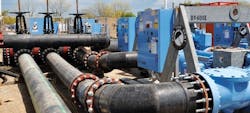About the author: Mary Miller is segment marketing manager for Rain for Rent. Miller can be reached at [email protected] or 661.387.6217.
Putting a liquid bypass in place typically is a straightforward process. But when a wastewater treatment facility located in the Northeast wanted to start constructing a new pump station, it faced a situation that was anything but typical.
The facility had significant space limitations, including an effluent pit that only could hold a small volume of liquid. At the same time, the facility was concerned with unpredictable variations in flow due to storm water surges and greatest operating cycles. Because the effluent pit would fill in minutes during peak storm season, the bypass system design had to be responsive, variable and fast.
With these concerns in mind, Rain for Rent was identified, based on engineering expertise and reputation, to design and install an automated solution that would effectively and efficiently support the yearlong project. The design employed electric pumps combined with special instrumentation that calculated the level of water in the effluent pit and compared it with the benchmark levels required to keep the pumps running. The system also was designed to respond automatically when the water flow changed, to prevent overflows.
Critical Fail-Safe
To keep the 56-million-gal-per-day (mgd) facility operational during the pump station construction, the bypass was installed near the end of the water treatment cycle, drawing the treated water from the effluent pit and bypassing it into the discharge pipe.
At the same time, because the small effluent pit could hold just 2,500 gal of liquid, there was a real danger it could fill, overflow and flood the facility with effluent water, causing a potentially devastating environmental disaster if a large storm surge hit during peak operating times. Because of that threat, the margin of error for the bypass project was close to zero.
Automation Advantages
Automating the system was a critical element of the project, as the facility wanted to limit staff involvement as much as possible to control labor costs and eliminate human error while also ensuring reliability and fast response. The system was composed of pumps and instrumentation, which eliminated most human interactions by using submersible transducers to measure the level of water in the effluent pit, and then feeding that data to a Rain for Rent AnDRU box.
The submersible pressure transducers calculated the weight of the water based on its specific gravity, translating the weight into water level measurements within the effluent pit. The AnDRU box automated the system that controlled the pumps and alarms by interpreting that data and reporting the water level to a variable frequency drive (VFD). The VFD, in turn, controlled the pump speed, increasing or decreasing the flow based on the reported level.
Four-Pump System
To achieve the 56 mgd capacity, four 16-in. self-priming centrifugal electric pumps—the DV400 model—were installed with the capability of handling up to 16,000 gal per minute and 200 ft of head.
The system was designed so that once the capacity of the first DV400 pump was exceeded, a signal would be sent to a second pump system to activate it, followed by the activation of up to all four pump systems working together if necessary. Monitors and controls also ensured that the pumps were always primed and the effluent pit levels were managed. The four pumps were integrated into the system and designed to operate in parallel, with each using a submersible pressure transducer, an AnDRU box, a VFD and a DV400 electric pump.
With this solution, the wastewater treatment plant was able to focus on its primary objective—the pump station construction—without experiencing any setbacks during the bypass installation. Most importantly, the plant was able to operate without disruption.
Download: Here


